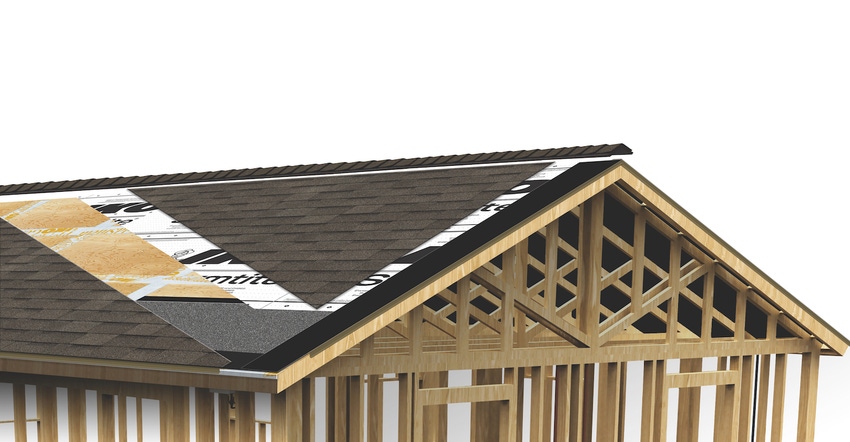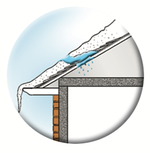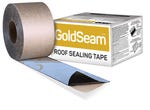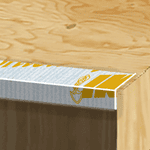Reducing the Risk of Water Infiltration in Roofing
Unwanted water infiltration can do considerable damage to a home, but roofing product manufacturers have accessories and components, like ice and water protector and seam tapes, which can help reduce these risks.

According to the Insurance Information Institute, in a given year, approximately one in every 50 insured homes in the United States will have a property damage claim related to water damage or freezing. With claims averaging just north of $11,000, it makes sense to build a roofing system that is designed to minimize the risks caused by wind-driven rain and ice dams. Two products that help prevent water damage on a roof system are ice and water protector and seam tape.
Ice and water protector is a building code requirement in many, but not all, parts of the United States and Canada. These adhesive-backed waterproof membranes are designed to protect vulnerable areas of a roof from ice and water damage by adding a layer of polymer-modified bitumen under the first few courses of shingles.
Installed prior to the roof system’s underlayment, ice and water protector is layered and overlapped from low to high along eaves, on overhangs and valleys, and around any feature that penetrates a roof deck. This includes vent stacks, dormers, skylights and chimneys. The aim is to protect any areas vulnerable to water infiltration due to ice dams or wind-driven rain.
 On protected deck surfaces, any wind-driven rain that manages to find its way under shingles will not make contact with the bare wood of the deck. In northern reaches and colder regions, ice dams caused by freeze-thaw cycles can create conditions where water can back up against the ridge of ice and be pushed under shingles, putting unprotected deck surfaces at risk for damage.
On protected deck surfaces, any wind-driven rain that manages to find its way under shingles will not make contact with the bare wood of the deck. In northern reaches and colder regions, ice dams caused by freeze-thaw cycles can create conditions where water can back up against the ridge of ice and be pushed under shingles, putting unprotected deck surfaces at risk for damage.
Ice dams form most commonly on poorly ventilated roofs and poorly insulated attic spaces. They begin when snow melts on an upper (warmer) roof area, and the resulting melt water freezes near the gutters, which are located in the cooler eave area. In severe cases, the ice can extend into the gap at the eaves and soffit as well as up onto the deck. This ice dam can force subsequent melt water upslope, between and beneath the shingles.
To protect the wood roof deck from potential damage, ice and water protector needs to extend above the highest expected level of ice-dam formation. Some building codes set a minimum requirement for coverage, which may require the use of multiple full courses of ice and water protector.
In some cases, a homeowner will request the use of ice and water protector on the entire roof deck surface to further enhance the waterproof protection under the shingles. When this is done, a thorough review of the attic ventilation is advised as underventilated spaces may cause other concerns during the warmer months.
With water’s ability to find its way into a building through the smallest openings, sealing the spaces between the OSB or plywood roof sheathing, as well the space between the deck and fascia boards, is another way to bulk up the performance of the roof.
 Installed prior to underlayment, seam tape applied to roof deck joints provides additional protection against infiltration. Much like shingle application, the seam tape is applied to lower areas of the roof first so that the layering of overlaps will allow the roof to shed any water that manages to reach the tape.
Installed prior to underlayment, seam tape applied to roof deck joints provides additional protection against infiltration. Much like shingle application, the seam tape is applied to lower areas of the roof first so that the layering of overlaps will allow the roof to shed any water that manages to reach the tape.
 When protecting the gap between the deck and fascia, sealing tape is applied prior to the drip edge. In addition to helping prevent the infiltration of water at one of the most vulnerable areas of a roof, along the eaves, the sealing of this gap makes it more difficult for undesirable guests like bugs and rodents to find their way into a home.
When protecting the gap between the deck and fascia, sealing tape is applied prior to the drip edge. In addition to helping prevent the infiltration of water at one of the most vulnerable areas of a roof, along the eaves, the sealing of this gap makes it more difficult for undesirable guests like bugs and rodents to find their way into a home.
Unwanted water infiltration can do considerable damage to a home, but roofing product manufacturers have accessories and components, like ice and water protector and seam tapes, which can help reduce these risks.
Read more about:
caulks/sealantsAbout the Author(s)
You May Also Like






